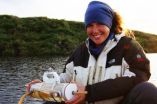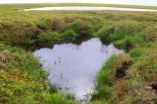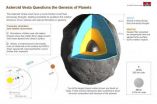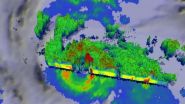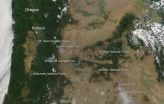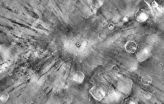(Press-News.org) New University of Alaska Fairbanks research indicates that arctic thermokarst lakes stabilize climate change by storing more greenhouse gases than they emit into the atmosphere.
Countering a widely-held view that thawing permafrost accelerates atmospheric warming, a study published this week in the scientific journal Nature suggests arctic thermokarst lakes are 'net climate coolers' when observed over longer, millennial, time scales.
"Until now, we've only thought of thermokarst lakes as positive contributors to climate warming," says lead researcher Katey Walter Anthony, associate research professor at the UAF Institute of Northern Engineering. "It is true that they do warm climate by strong methane emissions when they first form, but on a longer-term scale, they switch to become climate coolers because they ultimately soak up more carbon from the atmosphere than they ever release."
Walter-Anthony is traveling, however she and collaborators will be available for an audioconference press briefing Wednesday, July 16 at 1:30, Alaska time (5:30 p.m. Eastern U.S.)
Found in the Arctic and cold mountain regions, thermokarst lakes occur as permafrost thaws and creates surface depressions that fill with melted fresh water, converting what was previously frozen land into lakes. Researchers observed that roughly 5,000 years ago, thermokarst lakes in ice-rich regions of North Siberia and Alaska began cooling, instead of warming the atmosphere.
"While methane and carbon dioxide emissions following thaw lead to immediate radiative warming," the authors write, "carbon uptake in peat-rich sediments occurs over millennial time scales."
Using published data from the circumpolar arctic, their own new field observations of Siberian permafrost and thermokarsts, radiocarbon dating, atmospheric modeling, and spatial analyses, the research team studied how thawing permafrost is affecting climate change and greenhouse gas emissions.
Researchers found that "thermokarst basins switched from a net radiative warming to a net cooling climate effect about 5000 years ago," according to their article, published online today. They found that high rates of carbon accumulation in lake sediments were stimulated by several factors, including "thermokarst erosion and deposition of terrestrial organic matter, […] nutrient release from thawing permafrost that stimulated lake productivity, and by slow decomposition in cold, anoxic lake bottoms."
"These lakes are being fertilized by thawing yedoma permafrost," explained co-author Miriam Jones, research geologist for the U.S. Geological Survey. Yedoma is a type of permafrost that is rich in organic material. "So mosses and other plants flourish in these lakes, leading to carbon uptake rates that are among the highest in the world, even compared to carbon-rich peatlands."
The study also revealed another major factor of this process: Researchers found that when the lakes drain, previously thawed organic-rich lake sediments refreeze. The new permafrost formation then stores a large amount of carbon processed in and under thermokarst lakes, as well as the peat that formed after lake drainage. Researchers note that the new carbon storage is not forever, since future warming will likely start rethawing some of the permafrost and release some of the carbon in it via microbial decomposition.
As roughly 30 percent of global permafrost carbon is concentrated within 7 percent of the permafrost region in Alaska, Canada, and Siberia, this study's findings also renew scientific interest in how carbon uptake by thermokarst lakes offsets greenhouse gas emissions. Through its data collection, the study expanded the circumpolar peat carbon pool estimate for permafrost regions by more than 50 percent.
INFORMATION:
This international collaboration has received funding or support from: The Alfred Wegener Institute, National Science Foundation, University of Alaska Fairbanks, and the U.S. Geological Survey.
NOTE TO EDITORS: Photos are available for download from http://bit.ly/arcticlakes2014.
AUDIOCONFERENCE INFORMATION:
For journalists in the U.S. and Canada, the number is 800-893-8850. The PIN is 1211736.
International media can access the audioconference by calling +011-503-295-8000. Enter 800-893-8850 and the PIN: 1211736.
ADDITIONAL CONTACTS:
Katey Walter Anthony
Assistant research professor
Institute of Northern Engineering
University of Alaska Fairbanks
Office: 907-474-6095
Email: kmwalteranthony@alaska.edu
Miriam Jones
Research geologist
United States Geological Survey
Office: 703-648-6936
Email: miriamjones@usgs.gov
Guido Grosse
Geoscientist
Division of Geosciences and Periglacial Research
Alfred Wegener Institute
Phone: +49-331-288-2150
Email: guido.grosse@awi.de
F. Stuart Chapin
Professor emeritus
Institute of Arctic Biology
University of Alaska Fairbanks
Office: 907-474-7922
Email: terry.chapin@alaska.edu
Study: Climate-cooling arctic lakes soak up greenhouse gases
2014-07-16
ELSE PRESS RELEASES FROM THIS DATE:
Scientists find way to trap, kill malaria parasite
2014-07-16
Scientists may be able to entomb the malaria parasite in a prison of its own making, researchers at Washington University School of Medicine in St. Louis report July 16 in Nature.
As it invades a red blood cell, the malaria parasite takes part of the host cell's membrane to build a protective compartment. To grow properly, steal nourishment and dump waste, the parasite then starts a series of major renovations that transform the red blood cell into a suitable home.
But the new research reveals the proteins that make these renovations must pass through a single pore ...
Asteroid Vesta to reshape theories of planet formation
2014-07-16
EPFL researchers have a better understanding of the asteroid Vesta and its internal structure, thanks to numerical simulations and data from the space mission Dawn. Their findings, published today in Nature, question contemporary models of rocky planet formation, including that of Earth.
With its 500 km diameter, the asteroid Vesta is one of the largest known planet embryos. It came into existence at the same time as the Solar System. Spurring scientific interest, NASA sent the Dawn spacecraft into Vesta's orbit for one year between July 2011 and July 2012.
Data gathered ...
NASA sees Typhoon Rammasun exit the Philippines
2014-07-16
Typhoon Rammasun passed through the central Philippines overnight and NASA satellite imagery showed that the storm's center moved into the South China Sea. NASA's TRMM satellite showed the soaking rains that Rammasun brought to the Philippines as it tracked from east to west.
Before Rammasun made landfall, the Tropical Rainfall Measuring Mission or TRMM satellite passed over the storm and measured cloud heights and rainfall rates. On July 14, 2014 at 18:19 UTC (2:19 p.m. EDT), TRMM spotted powerful, high thunderstorms reaching heights of almost 17km (10.5 miles). Rain ...
Researchers demonstrate health risks posed by 'third hand' tobacco smoke
2014-07-16
Research led by the University of York has highlighted the potential cancer risk in non-smokers – particularly young children – of tobacco smoke gases and particles deposited to surfaces and dust in the home.
Until now, the risks of this exposure known as 'third hand tobacco smoke' have been highly uncertain and not considered in public policy.
However, a new study published in the journal Environment International, has estimated for the first time the potential cancer risk by age group through non-dietary ingestion and dermal exposure to third hand smoke. The results ...
Squid skin protein could improve biomedical technologies, UCI study shows
2014-07-16
Irvine, Calif., July 16, 2014 – The common pencil squid (Loliginidae) may hold the key to a new generation of medical technologies that could communicate more directly with the human body. UC Irvine materials science researchers have discovered that reflectin, a protein in the tentacled creature's skin, can conduct positive electrical charges, or protons, making it a promising material for building biologically inspired devices.
Currently, products such as retinal implants, nerve stimulators and pacemakers rely on electrons – particles with negative charges – to transmit ...
National Psoriasis Foundation awards $1.05 million in research grants
2014-07-16
PORTLAND, Ore. (July 16, 2014)—Thirteen scientists received a total of $1.05 million in funding from the National Psoriasis Foundation for projects that aim to identify new treatments and a cure for psoriasis—an autoimmune disease that appears on the skin, affecting 7.5 million Americans—and psoriatic arthritis—an inflammatory arthritis that affects the joints and tendons, occurring in up to 30 percent of people with psoriasis.
Learn more about the NPF research grant program: http://www.psoriasis.org/research.
This year, three scientists each received a two-year, $200,000 ...
70-foot-long, 52-ton concrete bridge survives series of simulated earthquakes
2014-07-16
VIDEO:
A 70-foot-long, 52-ton concrete bridge survived a series of earthquakes in the first multiple-shake-table experiment in the University of Nevada, Reno's new Earthquake Engineering Lab, the newest addition to the...
Click here for more information.
RENO, Nev. – A 70-foot-long, 52-ton concrete bridge survived a series of earthquakes in the first multiple-shake-table experiment in the University of Nevada, Reno's new Earthquake Engineering Lab, the newest addition to the ...
Dozens of fires plague Oregon
2014-07-16
Fires are a way of life during the hot, dry summer days, but that does not mean they are ever taken for granted. Thousands of lightning strikes Sunday (7/13) and early Monday (7/14) probably started most of the wildfires, which are burning on private, public and reservation land. Dozens of fires are plaguing the forest areas in the state of Oregon. In this image, are shown the Buzzard Fire, the Shaniko Butte fire, the Bridge 99 Complex fire, and the Saddle Draw Fire.
The Buzzard Complex fire began as a lightning strike. Difficult terrain, combined with extremely dry ...
Arizona State University, US Geological Survey project yields sharpest map of Mars surface properties
2014-07-16
Tempe, Ariz. -- A heat-sensing camera designed at Arizona State University has provided data to create the most detailed global map yet made of Martian surface properties.
The map uses data from the Thermal Emission Imaging System (THEMIS), a nine-band visual and infrared camera on NASA's Mars Odyssey orbiter. A version of the map optimized for scientific researchers is available at the U.S. Geological Survey (USGS).
The new Mars map was developed by the Geological Survey's Robin Fergason at the USGS Astrogeology Science Center in Flagstaff, Ariz., in collaboration ...
Organismal biologists needed to interpret new trees of life
2014-07-16
Rapidly accumulating data on the molecular sequences of animal genes are overturning some standard zoological narratives about how major animal groups evolved. The turmoil means that biologists should adopt guidelines to ensure that their evolutionary scenarios remain consistent with new information—which a surprising number of scenarios are not, according to a critical overview article to be published in the August issue of BioScience and now available with Advance Access.
The article, by Ronald A Jenner of the Natural History Museum in London, describes how evolutionary ...
